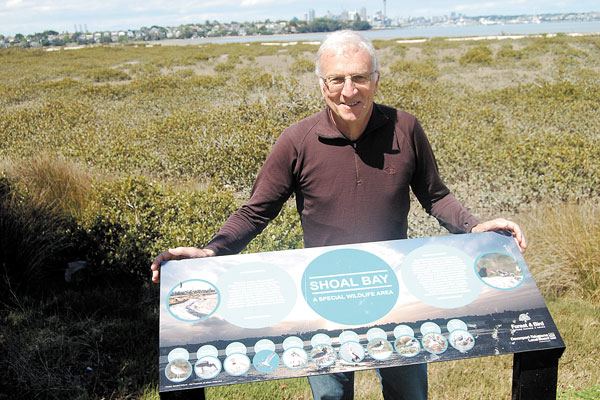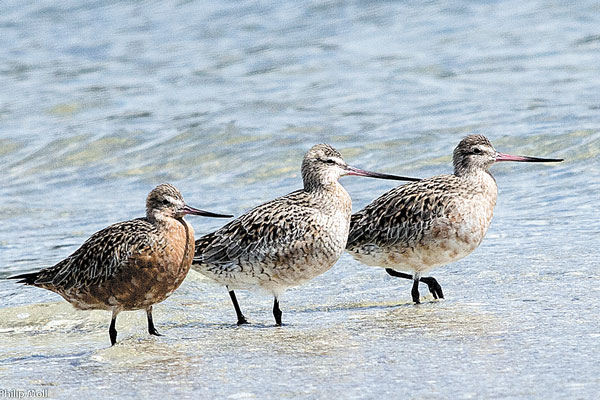What's New
30 October, 2018
Interview: Philip Moll.. Birdman of Bayswater

Philip Moll is a conservationist, photographer and guardian of Ngataringa and Shoal Bays and their wetlands. He talks to Helen Vause about his work and the growing interest in this special habitat.
It’s largely thanks to Philip Moll that informative signs were installed a few years ago around the shorelines of Ngataringa and Shoal Bays to explain the delicate habitat and its importance to all the shorebirds that live there.
The Hauraki resident is one of the key figures in the newly formed Bayswater Environment Action Committee (BEAC).
It came together this year after like-minded people started to get in touch, wanting to work with him, says Moll.
On Labour Weekend he addressed a group of nearly 100 residents who gathered at the edge of Ngataringa Bay to welcome the migratory godwits.
The exhausted birds had touched down on the shell banks just days earlier, after their long non-stop journey from Alaska.
They were pretty much on time for their annual visit. About 200 were observed on the shell bank, unaware of the welcome party and sausage sizzle under way in their honour nearby.
Moll was delighted with the number who turned out for BEAC’s first event on the Bayswater peninsula, taking the opportunity to hear about the godwits, other shorebirds, the habitat and the other birds that live nearby.

“This is a biodiversity hotspot,” says Moll, “and it’s under threat. Coexisting with the birds just calls for a little more awareness and understanding. Things like not walking on the tops of the sandbanks where the birds nest, and not walking so close as to disturb the birds or cause them to rise up and expend energy they’re going to need for their next journey.”
A curiosity and passion for the world around him started for Moll as a boy growing up in Hampshire, England. Badger-watching captured the imagination of a lad who’d often tear off after dinner on his bike to be at the creatures’ habitat just on dusk. He’d wait quietly in any suitable tree he could climb to watch over the entrance to the badgers’ burrow, waiting for one of the creatures to emerge as night fell.
Sometimes badger-watching brought various perils. Legs would go numb from sitting in trees, and there was the scary prospect of getting back out of the woods alone in the dark and pedalling home again. And there was the night he heard a piercing scream – it was a vixen fox, the freaked-out teen later realised.
“It was pretty exciting out there and I was just hooked on natural history.”
A few years later his family moved to Surrey and Moll, now a young man, had nearby Horsell Common to roam in. There was wildlife aplenty to watch, with deer, badgers, foxes and more in abundance on the common.
There was more to feed the imagination too: the sandpits in the common were the sites where the invading Martians landed their spacecraft in HG Wells’ science-fiction novel War of the Worlds.
Moll brought a passion for wildlife photography to his outdoor rambles and great curiosity for natural history, documenting much of what he observed on film.
And although he moved with his wife and family to New Zealand in 1993, on return visits to the UK he contributed bags of photographic images to keepers of history there; he’s happy that so many of his pictures are in the collections at the acclaimed Lightbox Gallery in Woking, Surrey.
In New Zealand too, Moll’s beautiful photos have helped augment his conservation work, both by raising awareness and by bringing compelling evidence to the desks of bureaucrats and decision makers, thus supporting his many tussles in the name of conservation work. His pictures have a power of their own.
As a newcomer to a country where his beloved mammals would be equated with pests, the forests and creatures of his new homeland had to be discovered. One step was a walk at Smiths Bush in Northcote in 2008, and other bush walks on the North Shore.
In 2011, he made his first trip to Miranda in the Firth of Thames, home of the Miranda Shorebird Centre. He laughs at the memory of not realising he’d got the tide time wrong for his first serious bird-watching foray. But he returned time and again to Miranda, observing the shorebirds and learning about them and their habitat. It was a whole new fascination.
The trips to Miranda set him wondering about what was on his own doorstep – Shoal Bay. There were no signs in those days to indicate what he was already starting to think; that this place was just like Miranda and that no one else seemed to have very much interest in this local gem.
Moll began searching the internet for more information about the habitat, the shell banks, what species lived there, their status, the protection plans and more.
He soon found the shell banks around Shoal and Ngataringa Bays were known as Chenier shell banks, and that they were a pretty rare feature on a world scale. He didn’t know much about the birds he had started to observe but the trusty camera helped accelerate his interest when he got a great shot of an overhead flock. When he enlarged that photo at home he realised he’d captured images of 38 wrybil on the wing, the birds with a distinctive right-curving bill. There are only about 5000 of them in the world and here they were in his bay.
He became more and more interested in the habitat that’s now acknowledged as a trove of biodiversity, with about 40 bird species in the environs that are either resident or visit, like the godwits, to refuel, rest and breed before they take off again. It’s estimated about 12 of those species are at risk from human activity on the land around them.
“When I first started taking more interest in the bay I just couldn’t believe there was little or no signage. To me it just seemed incredible that awareness was apparently so low. People were able to walk all over the nesting areas and so were their dogs.”
He pushed hard for the interpretive signs that was installed in 2014, followed (but not for another two years) by the installation of official signs to keep dogs out of the area. Around that time he was working with a growing group on predator control. In addition to monitoring, photographing and lobbying for active protection measures, he was also out attending to bait stations around the bay.
Moll is still incredulous that active interest in and protection for this special stretch of shoreline was all so tenuous. But he is pleased to be a driving force in changing times and to be raising awareness in a neighbourhood where more and more like-minded people are coming forward to join him.
Word has spread of many of his conservation initiatives. His school talks, he says, have been a particular success, and he’s found the level of interest among local school children he has addressed to be very gratifying.
The pressure is on like never before for these waterways, says Moll, with adjacent developments under way and more works pending.
“The focus has been all about the human environment here and not about the natural environment, even though these are very significant and important sites. Surely we don’t want to diminish these places. Surely the council doesn’t want to diminish them. Surely New Zealand doesn’t want that to happen.
“If you know what to look for there are already plenty of small warnings. This wildlife has been here a long time. Where will the birds go as the trees come down for development around Northboro Reserve?”
He says he’s aware of small slips related to current development work. More planned footpaths and the increase in runoff from many new houses will all threaten the balance of the surrounding bays, he warns.
“It’s very important that everyone knows we are here and we are watching.”
Source: Devonport Flagstaff 2 November edition. View Online.
